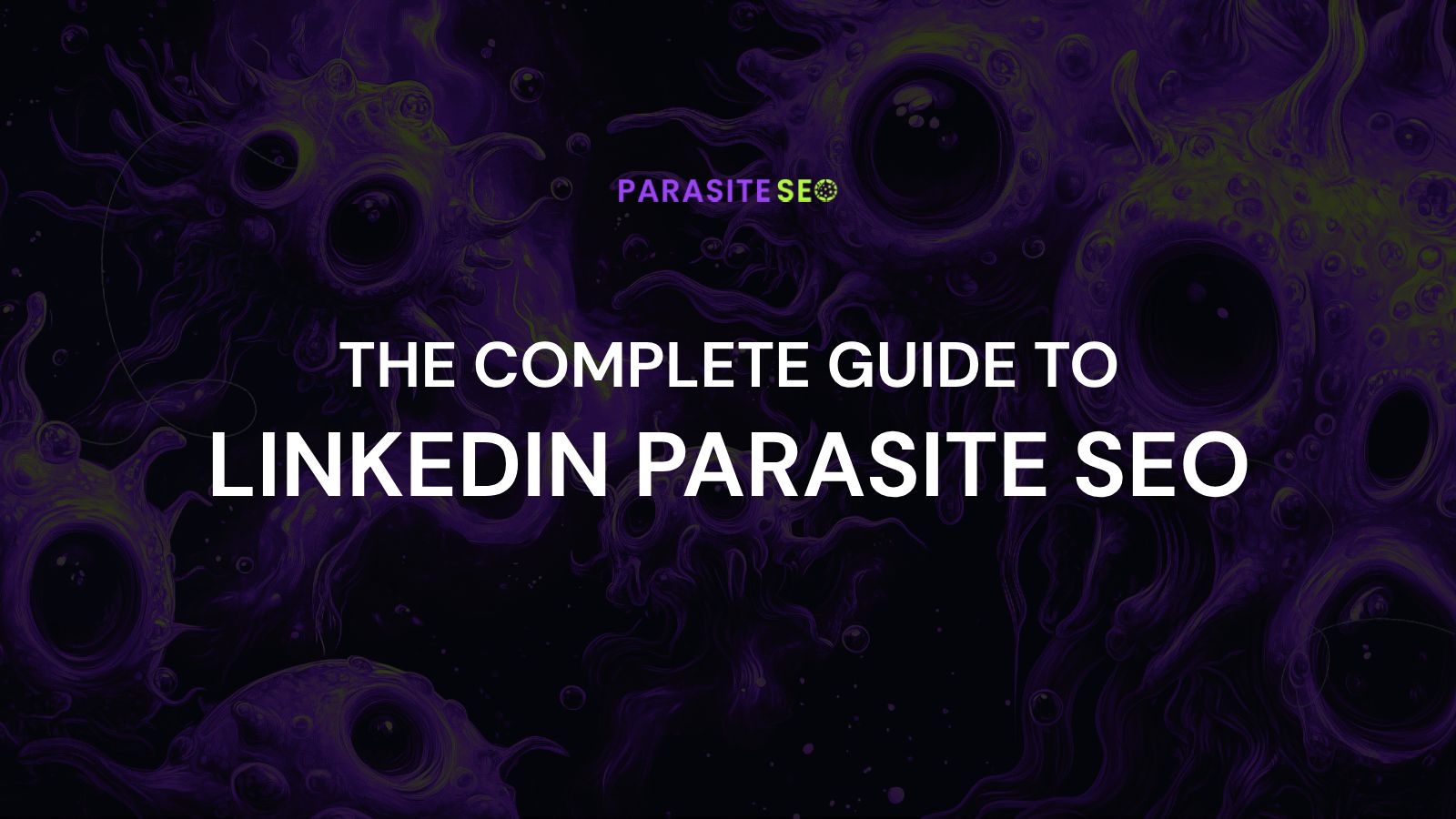
Want to rank content in Google without spending a penny on SEO?
LinkedIn Pulse articles offer a unique opportunity to leverage one of the web’s most authoritative domains for quick SEO wins – with zero investment required. This means infinite ROI potential for both personal projects and client work.
We’ll cover:
- How to optimize LinkedIn articles to rank in Google
- The fastest ways to get your content indexed
- How to turn this into a profitable client service
Let’s dive in.
What is LinkedIn Parasite SEO?
Parasite SEO involves leveraging high-authority third-party platforms to rank content in search results. LinkedIn, with its domain authority of 98, makes it an ideal host for this strategy.
The key advantage is that you’re borrowing LinkedIn’s massive authority rather than building your own from scratch. This allows you to potentially rank content much faster than you could on a new or lower-authority domain.
Real-World Success Stories
Let’s look at how different businesses have leveraged LinkedIn’s authority to dominate valuable search terms:
Local Service Industry
An employment agency targeted “employment agencies in Manchester UK”, reaching position #4 within weeks. For recruitment keywords worth hundreds per lead, this single ranking drives significant business value with zero ad spend.
However, you’ll note the map pack. I tend to avoid these keywords but in this case they will still be getting valuable leads.
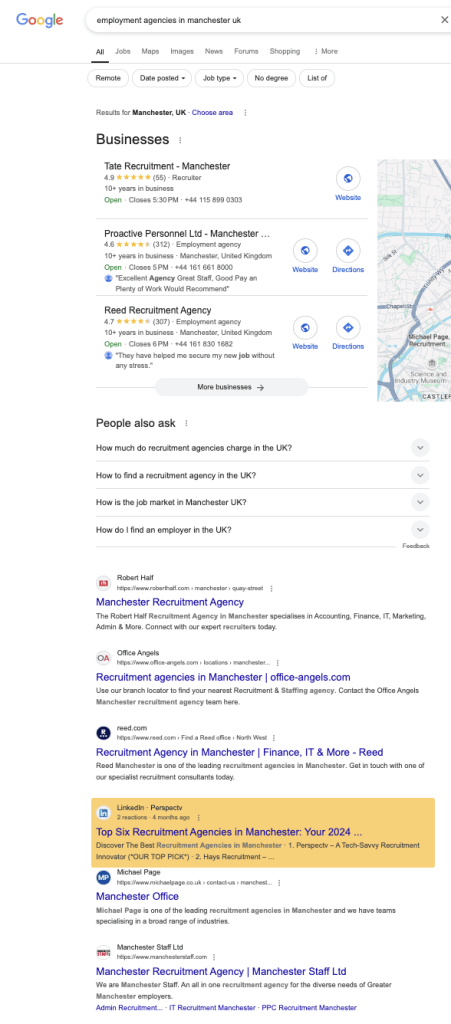
Financial Services
A finance site’s article about “best time to exchange currency” captured the featured snippet position. This high-intent keyword brings in daily qualified leads for currency exchange services.
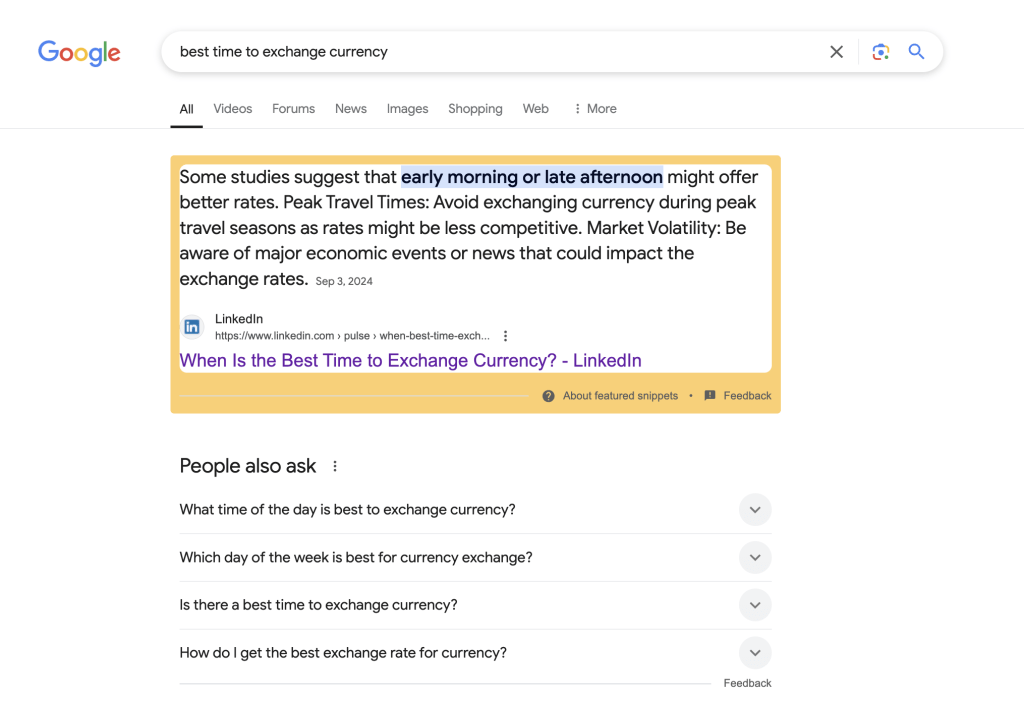
Education Services
An article targeting “best dissertation writing service” achieved the #1 position, demonstrating LinkedIn’s ability to rank for competitive education terms. Whether as a service provider or affiliate play, this ranking generates substantial monthly revenue.
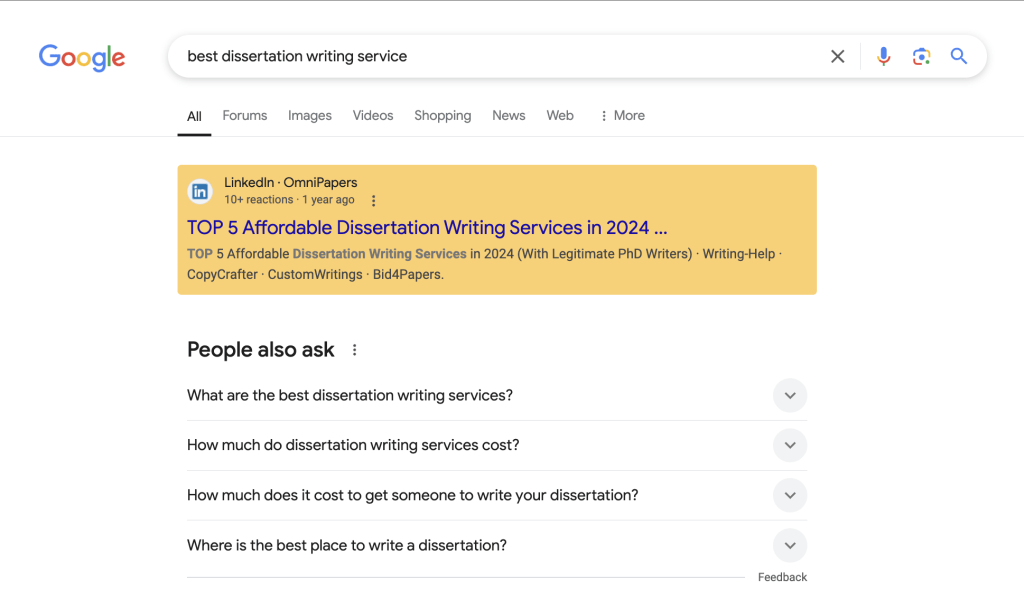
B2B Services
A business consultant’s article about “best executive coaching” secured the #2 spot – perfectly aligned with LinkedIn’s professional audience. This highly relevant positioning drives qualified B2B leads directly to their business.
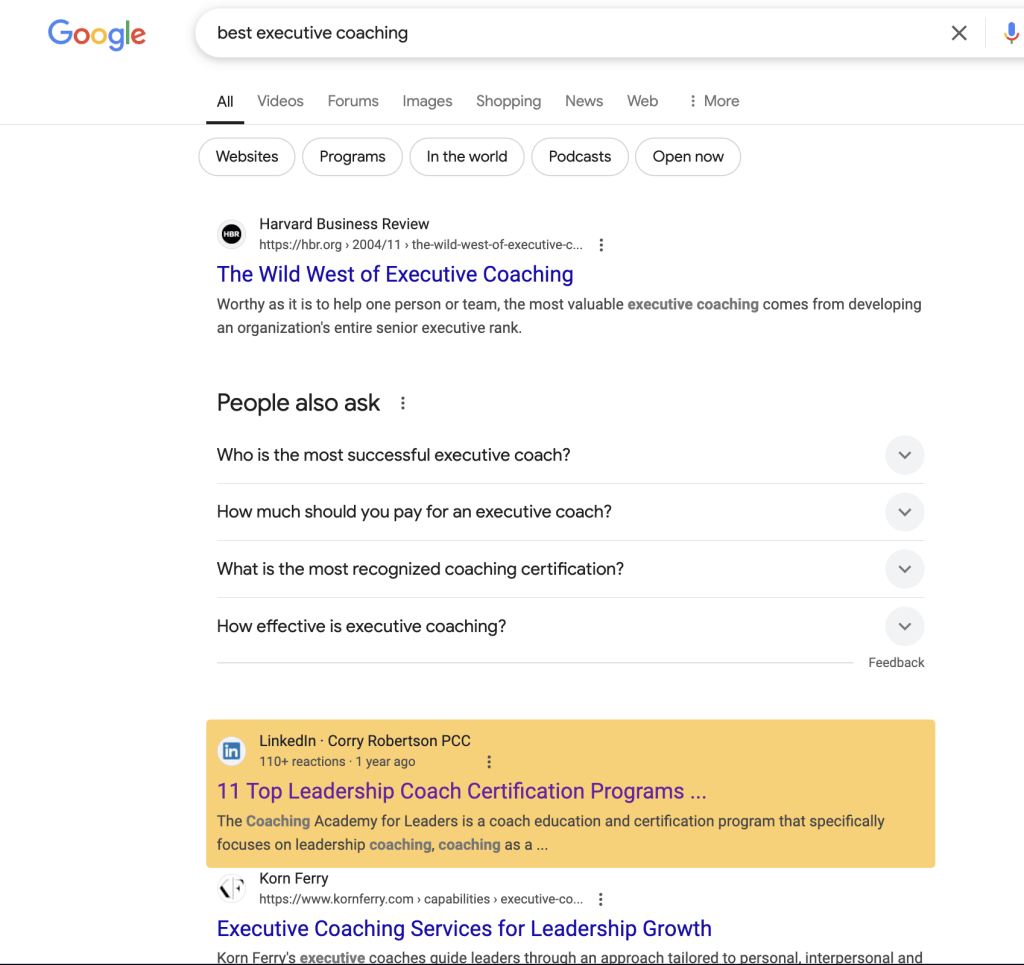
Construction Industry
A construction company’s analysis of “average price to build a house in Ohio” reached position #4. With each lead potentially worth $10,000+, even a few monthly conversions justify the minimal effort required.
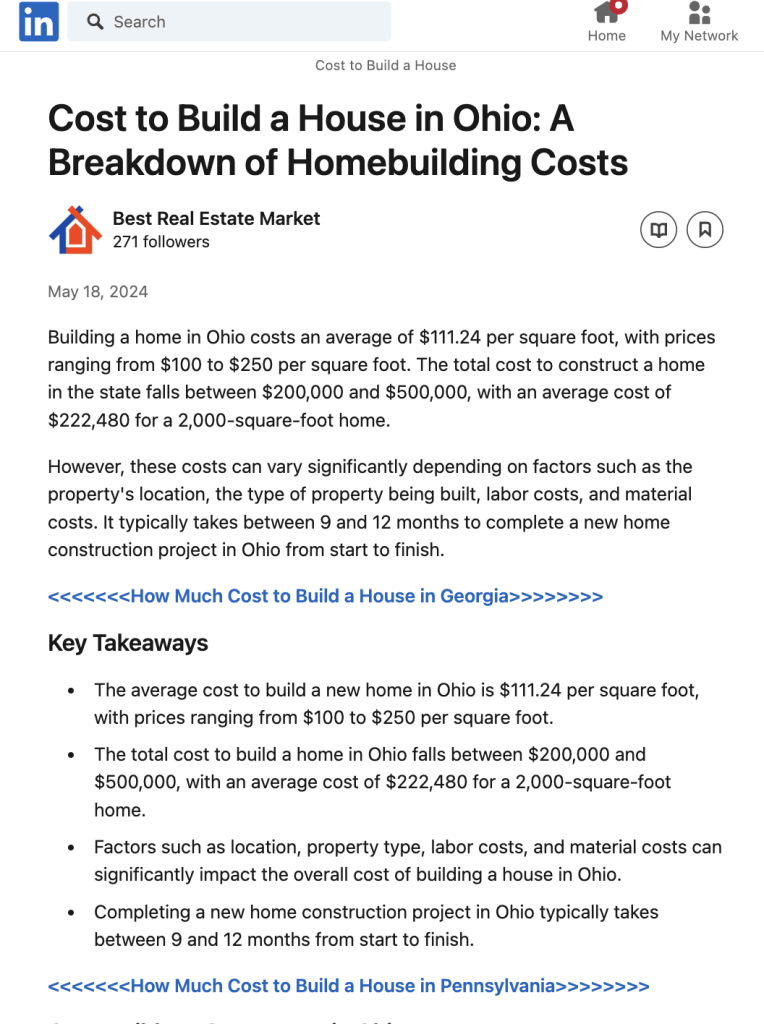
Investment Services
The most impressive example: an article about “how to transfer 401k to gold” captured the featured snippet. With premium commission rates in the gold IRA niche, this single ranking will be generating over $100,000 monthly in affiliate revenue.
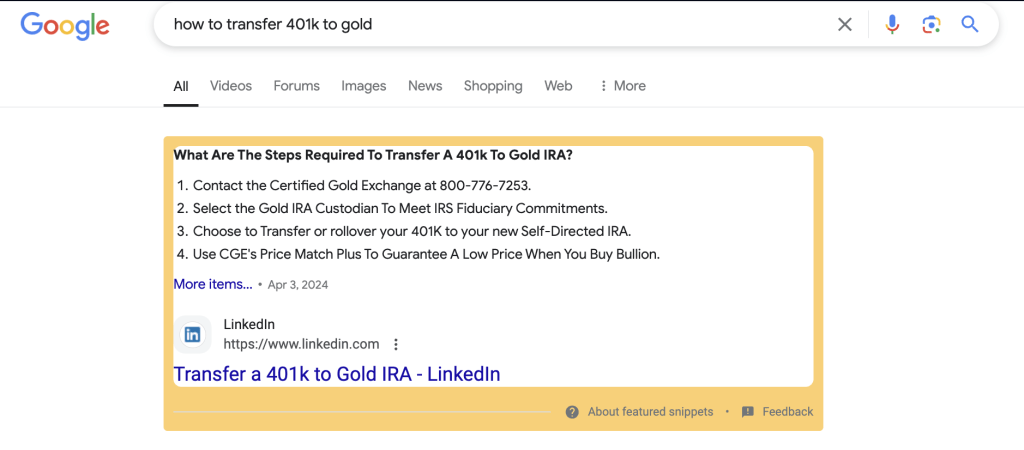
These examples demonstrate LinkedIn’s ranking power across various industries.
How to Create a LinkedIn Pulse Article: Step-by-Step
Publishing Articles
1. From Personal Profile:
-
- Log into your LinkedIn account
- Look for the “Write article” option on your homepage
- Click “Write article” to open the editor
2. From Company Page:
-
- Switch to your company page
- Click “Content” from your admin view
- Select “Write article”
- This opens the same editor as personal profiles
- OR click on the different profile in the article.
Creating a Company Page Steps (Recommended)
- Click the “Work” icon at the top of your LinkedIn homepage
- Click “Create a Company Page”
- Choose your page type:
- Small business (recommended for most cases)
- Medium to large business
- Showcase page
- Educational institution
- Fill in your company details:
- Company name
- LinkedIn public URL
- Website
- Industry
- Company size
- Type
- Upload your logo and banner image
- Add your tagline and company description
- Click “Create page”
- Verify your email if prompted
Optimizing LinkedIn Pulse Articles for Search
Here’s how to optimize your LinkedIn articles for maximum search visibility:
-
Title Optimization
This is generally the biggest factor in SEO. Your title tells google what the article is about and is the strongest ranking factor.
So…
- Include your target keyword in the title
- Keep titles under 60 characters
- Use power words to increase CTR
- Add year numbers when relevant (e.g., “LinkedIn SEO Guide 2024”)
I like to play around with this and also add secondary keywords in the title too.
Remember: With Linkedin the title will also be used the same in the URL.

-
Content Structure
Below is a great example of how to structure your content.
I have a full guide on how to write a roundup product review here.
- Place your main keyword in the first paragraph (optional)
- Include a CTA with an external link in the intro paragraph
- Use header tags (H2, H3) with relevant semantic keywords
- Include 1000+ words of high-quality content
- Break up text with bullet points and images
- Add LSI and additional variations of the seed keyword
- Place your main keyword or close variation in the conclusion H2
Here’s a FREE way to find additional keywords.

- Download the Keywords Everywhere chrome extension (there’s a few alternatives).
- Search your main keyword in Google.
- Check the ‘Related Keywords’ box.
It’s an easy and quick way to find additional keywords.
-
Extra On-Page Elements
- Add relevant images with keyword-optimized alt text
- Include internal links to other LinkedIn articles
- Use descriptive anchor text for all links
The Indexing Challenge (And How to Solve It)
One common challenge with LinkedIn articles is getting them indexed by Google.
Here are proven solutions:
-
Recommended Indexing Services
- OmegaIndexer (I use this)
- Idexmenow
- Indexification
Note: Only use these services for parasite content and to index backlinks. Using them for client websites can be risky due to potential spam associations. As you’ll find most tools index links with GSA links, so you don’t want this going to your website.
-
Manual Indexing Methods
- Share articles on social media platforms
- Create backlinks from other high-authority platforms
- Submit URLs through Google Search Console
- Use Google’s Indexing API (if you have access)
Monetizing LinkedIn Parasite SEO
Here’s how to turn this strategy into a profitable client service:
1. Quick Agency Wins
- Quick wins for clients or local businesses
- Cost-effective compared to traditional SEO
- Faster results than building site authority
- Professional branding on LinkedIn
Think about it.
If you have a client; local business, saas, anything!
Set up or use their company page on Linkedin, make sure you are added as a member so you can post on the account.
Then create 6-10 keyword targeted articles for the company.

You repurpose content from their blog, and rank articles much quicker, than most websites around.
Even if your client’s website ranks very well for the given keywords, you can take up more spots in the search results.
This can leak traffic to the main website, or increase brand searches further helping their SEO efforts.
Plus it pushes a competitor’s result further down the results, so a win all around.
2. Affiliate Marketing
- Target high-commission products ($500+ per sale) or SaaS
- Focus on B2B/professional products for better LinkedIn relevance
- Best performing verticals tend to be: Financial services (retirement accounts, investments, gold IRAs, etc.)
I’ve done this with much success!
I even did a parasite SEO video course 8 months ago, going from start to finish and promoting a software product.
That single article earned me 1000 usd, and that’s without even touching it again.
Follow this product review template for making a killer review.
You can also look at this from the angle if you own an ecommerce store or SaaS business.
Owning more money terms means less money you have to pay to affiliates, while still getting inbound traffic.
3. Online Reputation Management (ORM)
- Create positive content for client brands
- Push down negative search results
- Build authority profiles for executives
- Control page 1 rankings for brand terms
- Crisis management content strategy
One of our favorite services currently.
Owning more real estate on the first page of google, provides more opportunities for positive news on brand terms.
If it’s pushing down haters, or just controlling the narrative online, having a linkedin article in the SERPs helps with that.
Best Practices and Tips
Content Selection
- Focus on long-tail keywords
- Look for low-competition opportunities
- Choose topics relevant to your industry
- Check if Linkedin is already ranking
Like normal keyword research.
Check what’s working!
Put Linkedin.com in your SEO tool of choice.
And check if any relevant keywords are ranking for the keyword of your choice.
See if Linkedin is already ranking and has topical authority.
Next, target similar or long tail versions of the KW.
If the site is already on the first page of Google for your target Keyword reverse engineer why, and make your content better by adding information gain.
Note: you may have to do the strategy in the bonus section to outrank it.
Performance Tracking
- Monitor rankings with tools like Serprobot
- Track clicks with a link shorter
This is important for any Parasite SEO campaign.
You need to see what website, or in this case what article is generating the clicks and traffic.
If you want to be more granular, have unique links for each CTA in the article, to see what’s converting. This will help improve your content in the future.
You can also track rankings.
This depends on your goal. Personally I care about clicks only and don’t want to waste my time adding every article to a tracker.
Bonus
For those more competitive keywords.
Use Linkedin as you would a normal website.
Have a pillar article and supporting content then internally link them.
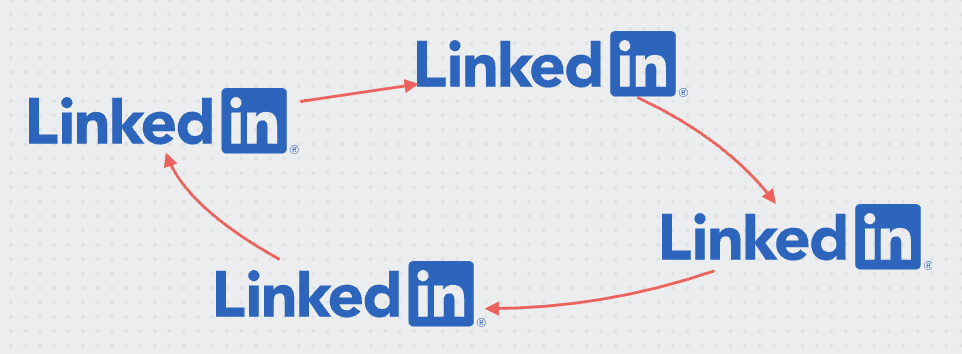
Maximizing Reach: The Content Multiplier Method
Want to double your search visibility with the same content? Here’s a little-known trick: Medium has similar domain authority to LinkedIn, and you can republish your content there in minutes.
Here’s how to execute this strategy:
1. Quick Republishing Steps
- Copy your LinkedIn article content
- Create a Medium account (or use an existing one)
- Click “Write” on Medium
- Paste your content (Medium maintains most formatting)
- Add your original images
- Set canonical URL to LinkedIn article (optional)
- Publish immediately
2. Automation Setup
- Use n8n or make.com for scaling
- Set up LinkedIn article monitoring
- Create automatic Medium posting
- Track rankings for both platforms
Pro Tip: Medium often ranks for different keyword variations than LinkedIn, giving you more search real estate without additional content creation.
Quick Hack: Use ChatGPT to slightly rewrite your intro and conclusion for Medium. This takes 30 seconds and can help avoid duplicate content issues while maintaining the core message.
I’ve seen articles rank on both platforms simultaneously, dominating more SERP real estate with zero extra effort. This works especially well for affiliate content and local business terms.
Account Management and Scaling
A critical aspect of LinkedIn parasite SEO is properly managing your publishing accounts. Here’s what you need to know about account sustainability and scaling:
-
Business Pages vs. Personal Accounts
- Create a business page rather than relying on personal accounts
- Business pages offer more credibility and stability
- Less likely to face restrictions compared to personal accounts
- Professional branding opportunities for clients
-
Publishing Frequency Guidelines
- Maintain 1-5 posts per week max for optimal sustainability
- Avoid aggressive posting (20+ articles daily) which can trigger restrictions
- Space out content publication throughout the day
- Mix content types (articles, regular posts, engagement)
-
Account Verification Benefits
- Verified accounts have higher posting allowances (up to 10 daily)
- More flexible content guidelines
- Enhanced trust signals for readers
- Better engagement rates
-
Best Practices for Longevity
You will mainly be using the Linkedin pulse article feature, however you want to use the social aspect to act like a real account.
This is mainly for people buying aged Linkedin accounts to stop the passport verification feature.
Common Mistakes to Avoid
- Don’t:
- Publish thin or duplicate content
- Stuff keywords unnaturally
- Use black-hat indexing techniques
- Neglect mobile optimization
- Avoid keywords with a map pack
- Do:
- Focus on user value first
- Maintain professional tone
- Update content regularly
- Build genuine engagement
Conclusion
LinkedIn parasite SEO represents a powerful opportunity for both personal branding and client services. By following the optimization and indexing strategies outlined above, you can achieve quick wins in search results while building a sustainable traffic source.
Remember to:
- Focus on quality content first (it converts better)
- Use indexing methods
- Track and document your results
- Scale gradually with proven success
With consistent application of these techniques, LinkedIn can become a valuable part of your SEO arsenal.
Looking for more Parasite opportunities? Try our tool ParasiteSEO.com.


